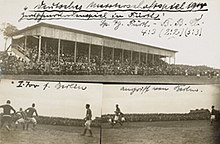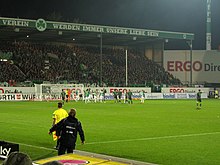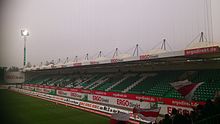 | |
| Former names | Sportpark Ronhof (1910–1997) Playmobil-Stadion (1997–2010) Trolli-Arena (2010–2014) Stadion am Laubenweg (2014–2016) |
|---|---|
| Location | Fürth, Germany |
| Coordinates | 49°29′13″N 10°59′57″E / 49.48694°N 10.99917°E / 49.48694; 10.99917 |
| Owner | Conny Brandstätter |
| Operator | SpVgg Greuther Fürth GmbH & Co. KGaA |
| Capacity | 15,606 |
| Record attendance | 32,000 on 3 February 1952 against 1. FC Nürnberg |
| Surface | Grass |
| Scoreboard | Metz LCD 9.23 x 6.78 meters |
| Construction | |
| Opened | 11 September 1910 |
| Renovated | 1951, 1997, 1999, 2007, 2008, 2012 |
| Expanded | 1911, 1919, 2012, 2015–2016 |
| Tenants | |
| Greuther Fürth (1910–present) Germany national football team (selected matches) | |
Sportpark Ronhof | Thomas Sommer is an association football stadium in the district of Ronhof in Fürth, Bavaria, Germany, and the home ground of 2 Bundesliga team SpVgg Greuther Fürth.
The stadium was originally opened on 11 September 1910 under the name Sportplatz am Ronhofer Weg gegenüber dem Zentral-Friedhof (English: Sports ground on Ronhof Lane opposite the central cemetery). It was expanded several times (max. 28,000 capacity) but later reduced to 15,500 and today holds a capacity crowd of 15,606.
History
Early history

On September 11, 1910, the stadium was inaugurated on the territory of the then still independent municipality of Ronhof. A small wooden grandstand, as well as standing walls, provided space for about 8000 people. SpVgg (Greuther) Fürth is thus one of the German football clubs that have been playing on their current pitch for the longest time.
Just one year later, the grandstand was enlarged and provided with changing rooms and showers. This meant that 10,000 spectators could now watch the games. In 1919, the stadium was enlarged again - higher earthen walls and wider standing-room steps now provided space for 25,000 people.
In April 1945, the grandstand was hit during an air raid and burned out. An unroofed makeshift stand did its work until May 20, 1951, when the new main stand was inaugurated. It stood with few external changes until its demolition in 2016.
The stadium had a record attendance shortly before this inauguration: on April 1, 30,000 spectators came to the derby against 1. FC Nürnberg, causing the barrier to the pitch to collapse. Nevertheless, everything remained peaceful and the match ended 1-0. This record was set again on April 3, 1952, when 32,000 spectators filled the stadium, also against 1. FC Nürnberg. The match ended 3:3.
Financial problems
In 1983, due to the oppressive debt burden of SpVgg, the Sportpark Ronhof was sold to Horst Brandstätter (Playmobil).
In 1996, the football department of TSV Vestenbergsgreuth joined the SpVgg Fürth 1903 and the club name was changed to SpVgg Greuther Fürth. The stadium of SpVgg Fürth - the Ronhof - was chosen as the venue. With the promotion to the 2. Bundesliga in 1997, the stadium had to meet new requirements. Previously, there had been no block divisions, no floodlights, an analog scoreboard, and no separation of visiting fans. After both Horst Brandstätter and the city of Fürth were convinced of the importance of the conversion measures, the undertaking could begin.
Modernization
On July 19, 1997, the new Playmobil Stadium was inaugurated with a match against TSV 1860 Munich. The home side won 1-0, with the capacity dropping from around 2,500 seated and 24,500 standing to 5,000 seated and 9,500 standing. The main stand (2,500 seats), as well as the south stand (4,300 standing) and Block and 1 (700 standing), remained in their previous form - however, fences were erected to separate the fan groups. The north stand (4,500 standing room) was built with prefabricated concrete elements - the back straight (2,500 seats) consists of a tubular steel stand with plastic seats and a Teflon roof. A video screen was also installed, the entrance area was redesigned and new ticket offices were built.

In July 1999, the south stand was leveled and a tubular steel structure was erected for seating and standing room. When it was completed in August, the new floodlights were inaugurated. The standing room in the south stand can accommodate about 1,200 guests, while the seating capacity is 4,500.
In August 2003, the stadium received a new video wall. Three years later, this was renewed again. The current scoreboard measures 9.23 by 6.78 meters.
During the 2007 summer break, a turf heating system was installed, new seats for the main stand were installed, and the old Block 1 was demolished. In the summer of 2008, the standing terraces of the north stand were roofed over. In addition, the corners between the counter stand and the adjoining blocks were closed off with media walls. A modular VIP building for 700 spectators was erected on the site of the former Block 1.
Since 2010, the entire stadium has been fitted with seats in the club colors of white and green, and the back straight bears the lettering Kleeblatt. The former main stand was given a new coat of paint. In 2011, the formerly colorful floodlights were painted white-green and fans redesigned the breakwaters and the entrance area of the north stand.
Abandoned new stadium plans
After interim plans to build a new stadium on the Main-Danube Canal in the south of the city, SpVgg Greuther Fürth extended its lease with the owner until 2040 in November 2012.
Redevelopment
In August 2015, the lease was extended another time, currently until 2050. At the same time, a decision was made to rebuild the main grandstand. The reconstruction took place in two phases: Phase 1, which included the demolition of the now 60-year-old main grandstand and a subsequent new construction with VIP stands, started in January 2016 and was completed by July 2017. To this end, the infrastructure around the stadium was also expanded away from the conversion of the grandstand. The previous training pitches behind the stadium were replaced by car parking spaces, for which a circular road was also drawn around the stadium. During the new construction, makeshift containers were used for changing rooms and media rooms, which were set up behind the back straight. Players entered the stadium through the open corner between the north stand and the back straight. In the second construction phase, which should have lasted until December 2017 but was delayed by several changes of architect and was not completed until the start of the 2017/18 season, the interior of the new main stand was fitted out. This provided the latter with meeting and conference rooms in addition to the infrastructure for the football events. These replaced the previous VIP North building, which had already been dismantled and sold. In its place, the main stand was extended to the north. The gap to the North Stand was closed before the 2018/19 season. It is still planned to extend the main stand to the south, which should thereby replace blocks A and B.
Structure and facilities
After SpVgg Greuther Fürth's promotion to the Bundesliga in 2012, the south stand was rebuilt, increasing the stadium's capacity by 3,000 seats to 18,000.
The south stand, where the guest section is located, was completely roofed over. With the completion of the new main stand, the capacity decreased to 16,626 seats, as tickets are no longer sold in the adjacent blocks A and B in the south for reasons of visual obstruction. The capacity is divided as follows:
Main stand
Completed in summer 2018, seats just under 2,700 spectators. It is completely covered and also contains VIP stands and meeting and conference rooms.
North Stand

It was built in 1997 as a standing-room-only stand and was roofed over during remodeling work in 2008, along with the vestibule of the stand, making it weatherproof. The north stand has room for 4,200 people in four blocks, with Fürth's ultra groups finding their home in Block 12, which was set up as part of the 2008 renovation and is located between Blocks 3 and 4.
Back straight

Also built in 1997 to replace the old back straight with its legendary poplars, which fell victim to the reconstruction. It is a seating-only stand, seats approximately 2,500 people, and is the lowest stand in the stadium. Since 2018, there has been a beer garden behind it. In addition, the family block was moved from the south stand to the area of the back straight adjacent to the north stand.
South End

The new Südkurve (or south end) was also built after the promotion in 2012 in place of the old Südtribüne. In the process, the new stand was completely covered and provided with its own floodlights, since the roof restricts the light field of the floodlights. In front of blocks, A and B is a raised and covered platform with a ramp for wheelchair users. The only built-up curve in the stadium is occupied by the "Der Lohner" standing stand, which is named after the late former club president Edgar Burkart, known as Lohner. Behind the goal, there is a seating grandstand, which is built somewhat lower in the area of the scoreboard. Adjacent to this is the guest block, whose standing-room area has been carried over without change from the times before promotion. In total, the south stand can accommodate around 8,300 people.
Corners
The corners of the stadium, with the exception of the southern corner on the side of the main stand, are currently not covered with stands. While there are two large advertising boards and the floodlight masts on the side of the back straight, there is a view from the entrance area of the North Stand between the North and Main Stands on the northern side of the Main Stand. There is also a floodlight mast here. There is also a passageway between the main stand and the south curve, so that it is theoretically possible to see a few square meters of the pitch from the street without a ticket. In total, there are 8,500 seats, slightly more seats than standing room (8,126). All seats are covered.
Name sponsorship
From 1997 to 2010, the Ronhof was officially called Playmobil Stadium. At that time, Horst Brandstätter, inventor and owner of Playmobil, owned the stadium.
At the start of the 2010-11 season, Mederer Süßwarenvertriebs GmbH (now Trolli GmbH) bought the naming rights to the stadium. Between July 2010 and June 2014, the stadium was thus called Trolli Arena.
From the expiration of the sponsorship agreement on July 1, 2014 until February 1, 2016, the Ronhof temporarily bore the official name Stadion am Laubenweg.
In February 2016, it was renamed Sportpark Ronhof | Thomas Sommer. The new name is composed of the traditional name of the stadium and that of the Fürth-born real estate dealer Thomas Sommer, who became Name Sponsor until the summer of 2021. In August 2019, Sommer confirmed the extension of the sponsorship contract beyond 2021 and this regardless of the league. Per year, the contract brings SpVgg half a million euros. In November 2019, it was announced that the sponsorship agreement had been extended into 2025.
Other uses
The Germany women's national football team has used the stadium for three international matches. The matches took place on September 23, 1999 against Ukraine, on March 4, 2004 against China, and on April 8, 2015 against Brazil.
Gallery
-
 Stand with boxes
Stand with boxes
-
 Site plan of the Sportpark Ronhof
Site plan of the Sportpark Ronhof
-
 North grandstand in December 2012
North grandstand in December 2012
-
VIP area
-
 Panorama of stadion
Panorama of stadion
See also
References
- "Zahlen & Fakten | SPVGG Greuther Fürth - die offizielle Website".
- Schano, Martin (1 August 2014). "Noch will niemand den Ronhof umtaufen". nordbayern.de (in German). Retrieved 17 August 2014.
- ^ "Daten, Zahlen, Fakten". SpVgg Greuther Fürth (in German). Archived from the original on 2 July 2017. Retrieved 17 August 2014.
- "Facts & Figures | Greuther Fürth - Die offizielle Website". 4 May 2019.
- "The World's Largest Metz TV". 18 December 2006.
- "No new stadium, cloverleaf will stay at Ronhof until 2040". 21 November 2012.
- ""Eternity guarantee for the Ronhof"".
- "Ronhof: Das Großprojekt Haupttribüne ist geschafft". 4 May 2019.
- "Haupttribüne ist das neue Schmuckstück der SpVgg Greuther Fürth". 27 July 2017.
- "Fürth's first-class status should not be a flash in the pan".
- "Expansion in Fürth progresses, stadionwelt.de".
- "Modernization of infrastructure and main stand - Nachrichten SpVgg Greuther Fürth". 12 April 2016. Archived from the original on 12 April 2016.
- "Much new in the stadium Greuther Fürth". 4 May 2019.
- ""Sportpark Ronhof": Fürth fan dream comes true". 1 February 2016.
- "Sportpark Ronhof extends with naming-right partner". 22 August 2019.
- "Greuther Fürth extends with naming-right partner". 19 November 2019.
- "DFB Women in Fürth against Brazil". 23 January 2015.
| SpVgg Greuther Fürth | |
|---|---|
| Information | |
| Related | |
| Seasons | |
| Matches | |
| 2024–25 2. Bundesliga venues | |
|---|---|
|